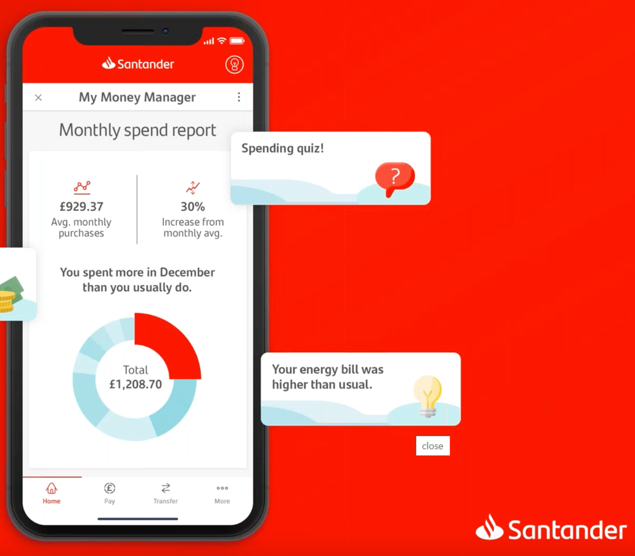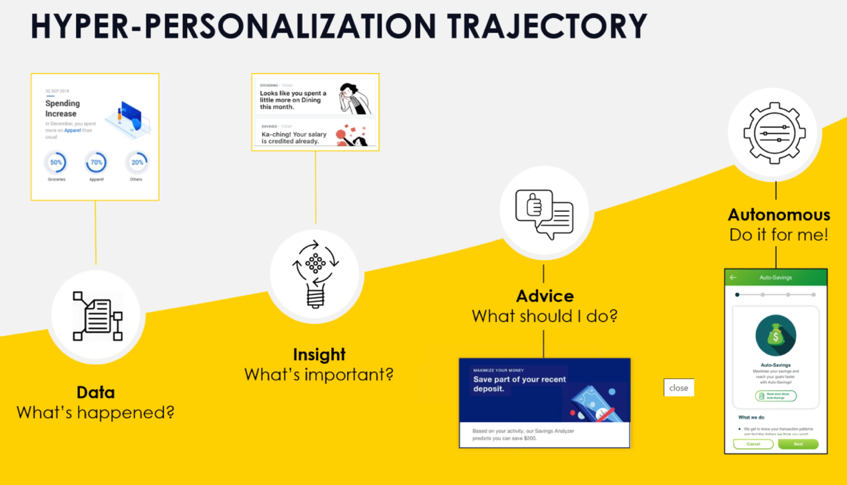February 22, 2021
Anticipate & Act: How Banks Compete in the Future of Digital Banking Experiences

Transformation in digital banking experiences is well underway. To understand where digital banking is headed, it is important to first understand how customer financial needs, behaviors, and expectations have evolved, and how financial institutions are responding.
In a recent webinar hosted by Personetics, Aurelie L’Hostis, Senior Analyst at Forrester Research, Andy Warren, Head of Digital Transformation at Santander UK, and Dorel Blitz, VP Strategy & Business Development at Personetics discussed the future of autonomous digital financial experiences, how financial institutions should prioritize and anticipate customer needs, and how to drive business impact through digital customer experiences.
Pandemic Behaviors Offer A Glimpse into the Future of Digital Banking
The pandemic fast-tracked the digital shift across industries, with a 35% growth in global digital banking. As the majority of consumers migrate to digital, the tech-savvy customer profile will become the norm, even in the post-pandemic era. Those consumers typically connect, according to Forrester, through five devices, four platforms, and three channels to access content, communication, and services.
But it’s not the number of devices that’s most important to understand this new consumer. It’s how they access content and services online. Today, multi-channel, multi-device experiences place too heavy a cognitive burden on the consumer. Digital experiences offer services to help consumers in their moment of need, but consumers still need to know what they want, where to look, and how to navigate the internet. They are still active and exhausted with searching and finding solutions for their financial needs and desires.
This contrast is highly visible in financial services, which still offer a complex hodgepodge of digital experiences. Customers’ lives are fluid and unpredictable. They need a better way to manage their finances but are not yet able to articulate the product that would help them do so. One in five adults in the US trusts a computer algorithm to make financial decisions on their behalf, yet financial services institutions are in the infancy of their proactive, smart, and personalized response.
The Evolution of Digital Experiences
Customers are on a multi-phase journey to more connected digital experiences. In the first phase, banking customers create personalized experiences for themselves, using a variety of standalone apps that help them borrow, save, and plan for the short and long term, and requiring them to proactively hop between platforms and channels.
The second phase eliminates the hopping, consolidating customer experiences on one platform. Platforms like Google Now and Alexa provide information necessary to address customer needs, and companies “borrow” mobile moments from partners to expand their services beyond their app. For example, Starling Bank utilizes open banking platforms to provide customers with third-party financial services in their online marketplace. Customers can browse financial services through their banking app, and those services are connected to their Starling account so they can manage everything in one place.
The future is in phase three and onward. In Phase 3, consumers ask open-ended questions and are presented with a curated set of solutions. They expect third parties to anticipate their needs and know their preferences. In the final phase, a virtual agent anticipates customer demands and responds with a complete solution, not simply a set of experiences. In this phase, data provides context and insights that allow companies to serve consumers better. Experiences lift the cognitive load off the customer, becoming more conversational, immersive, and participatory.
How Are Banks Responding?
Customers expect banks to uphold their end of a new “social contract” by helping their customers better manage their financial lives. To meet their new role, banks must deliver value and differentiate by anticipating customer needs and acting on the information. That requires them to get to Phase 3 and 4, using data to anticipate needs and then serving customers proactively on well-understood journeys with the right services and products. Some are starting to do so. Huntington Bank, US Bank, and Royal Bank of Canada, for example, are surfacing financial insights in a contextual way to help customers stay on top of their finances.
If they successfully combine open banking regulations, developments in personal online identity, data management, and AI, real-time interaction, intelligent agents, and cloud-native platforms, banks can deliver algorithm-driven financial services that make decisions or take action on the customer’s behalf—or autonomous finance. By truly lifting the burden off of their customers, this is the banks’ ultimate way to uphold their end of the contract. But it is also a business imperative if they want to retain customers and sell more valuable products and services to them.
Santander UK & Personetics: Insights to Reduce the Cognitive Load
For Santander UK, the pandemic highlighted the importance of creating a more emotional connection with customers digitally. The bank knew it needed to move beyond graphs and tables, to reduce its customers’ cognitive load and help them better manage their finances. The bank found that while customers showed an increased appetite to gain control of their financial lives, they often lacked the support to do so. More than a quarter of UK customers (28%) wanted to improve their financial awareness in 2021. Yet many, especially younger customers, were unaware of which payments left their accounts—over a third of young customers reported being regularly surprised by the cost of their household bills.
To give their customers a digital banking experience on par with other areas of their digital lives, Santander launched a partnership with Personetics, the global category leader in data personalization and customer engagement for financial services. Personetics helps banks leverage their biggest asset—their own customers’ financial transactional data—to quickly drive significant business impact and market differentiation.
Personetics and Santander launched “My Money Manager”, an in-app service designed to support customers in understanding their spend, and finding ways to save with clear, personalized insights. For example, customers are notified about duplicate subscriptions to similar products. The app tracks the status of refunds when online purchases are returned. When a one-year trial period on a utility bill ends, hiking tariff, the app alerts customers.

“My Money Manager” allows Santander UK to deliver the early steps in autonomous finance, and customers are responding, with over one million registered for the service in just a few months, and eight million personalized insights shared to date. Personetics allows Santander to collect ongoing feedback on how valuable each insight is for the customer, to better customize the customer’s personal experience, but also to teach Santander which insights are working, and which aren’t. In this way, Santander is delivering greater value to its customers and easing their burden, while continuously optimizing to strengthen customer trust. These efforts have earned the app a 4.6 out of 5-star rating by customers.
The Future: Moving Customers from FOMO to JOMO
Services like Santander UK’s “My Money Manager” are only the beginning. The evolution of digital banking means all banks should take action to play a smarter, more proactive role in their customers’ lives. How they can move customers from a state of FOMO, or fear of missing out, to JOMO, the joy of missing out, where customers become more passive in their banking because they trust their bank to make smart financial decisions on their behalf.
Personetics helps banks advance along this trajectory. It begins with helping banks capture their data, then categorize and deeply enrich it to understand customer financial behavior. The next step is to lead customers through a highly accurate, daily personalized journey with a combination of financial alerts, recommendations, and insights that increase engagement, NPS scores, and cross-selling.

Once enough trust has been secured, banks can offer automated financial wellness capabilities that amplify customers’ primary checking and savings accounts, including from external sources. The result is customer wealth built over time and a high level of trust. Banks that embrace customer advocacy by actually thinking for their customers will truly have an advantage in the future of digital experiences.
Want to explore how your bank can harness the power of AI to engage and serve customers? Request a demo now
Latest Posts

Why Asia Pacific Pacific Banks Must Lean into Cognitive Banking: A Conversation with Dr. Dennis Khoo

Explore our Spring Release Highlights – From Integrated Marketing Offers, to Custom Trackers, and AI Innovation

Showing the Human Side of Digital Banking: Insights from Desjardins' Nathalie Larue









